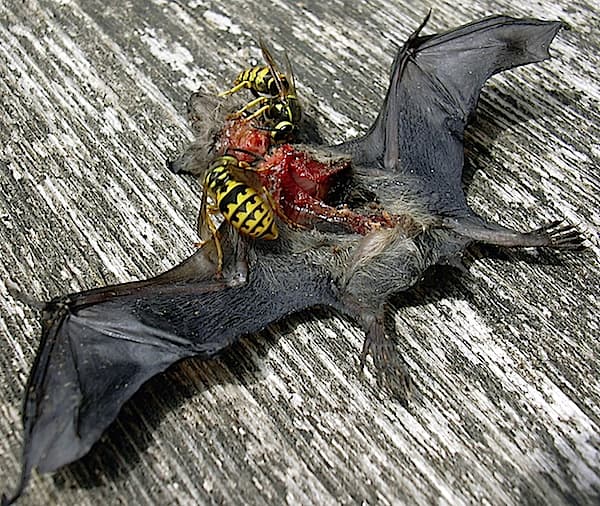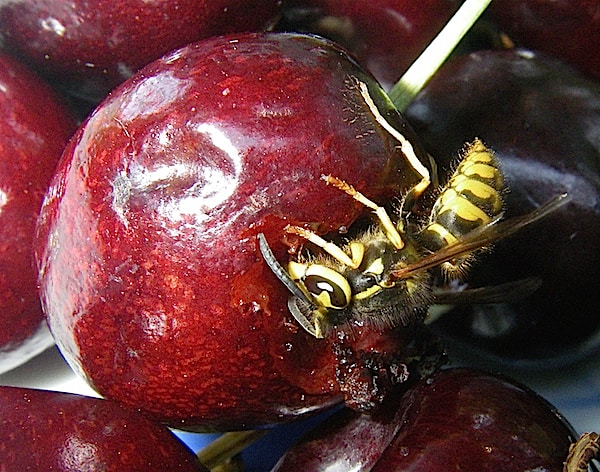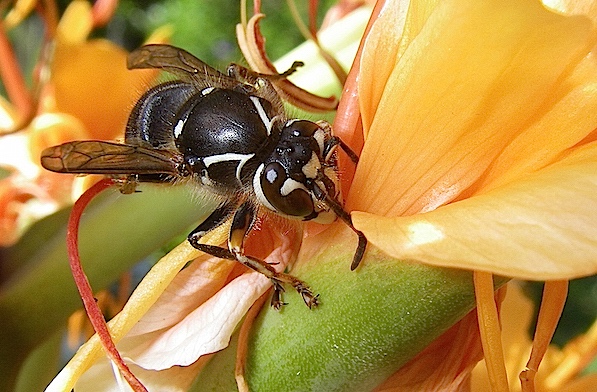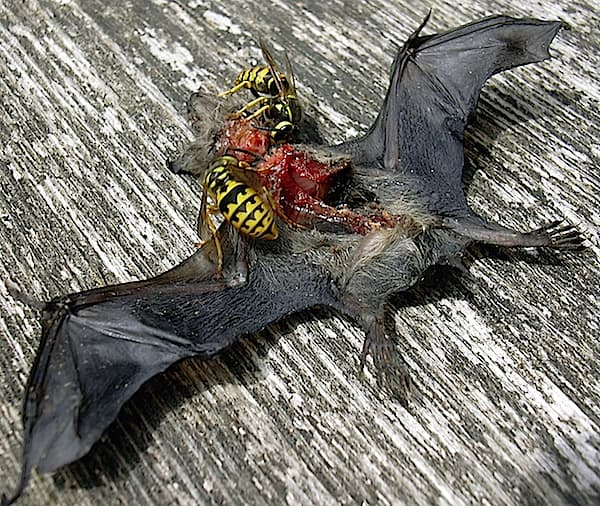Spheksophobia, a panic-inducing fear of Wasps, is one of the more widespread (and unpronounceable) phobias out there among humans, whose exaggerated instinct of self-preservation occludes all higher naturalist’s functions, such as trying to identify who is buzzing around the dinner table and who is nesting under the eaves of the house …
All Wasps are good – to a degree, even when viewed through the lens of human interest.
The common Western Yellowjacket, Vespula pensylvanica (yes, only one “n” : taxonomists don’t necessarily know how to spell), which can be truly annoying at a picnic table, provides enormous benefits to the environment by cleaning up dead things.

Unfortunately, from their point of view (or smell), your BBQ hamburger fully qualifies as “a dead thing”. This disrespectful failure to distinguish makes this species very unpopular and the target of much frenzied hostility.
Fruit growers also look upon these Wasps with extreme prejudice, since they will enjoy nibbling ripe fruit, the sweeter the better, whether on the branch or on the ground, or, for that matter, on your desert plate.

[An aside : even less enjoyable than the buzzing presence of Wasps on your dinner plate are those dinner guests at your table who, blind with fear, thrash their arms around wildly, increasing everybody else’s chances of being hit and stung by a swatted Wasp, which, before becoming the target of this flailing act of aggression, was peacefully focussing her attention on a bit of grizzle on somebody’s chicken drumstick.]
A few Wasp-basics : the group we are concerned with here are in the family Vespidae (by contrast, the Bees belong in the Apidae, twice removed from the Yellowjackets.) You know : Animalia, Arthropoda, Insecta, Hymenoptera and then a whole bunch of different groups, from so-called sawflies to countless parasitic wasps to highly social swarms of bees, wasps, and ants – yes, the ants are kissing-cousins. Take a moment, put on your reading glasses, and look closely at these marvels of the insect world. Just appreciate how well put together they all are : masterstrokes of evolution, every single one.

After falling into a yoghurt dish, this Vespula pensylvanica climbed onto the spoon handle and expertly and thoroughly cleaned herself. Her agility is remarkable : she already looks cleaner than any mammal will ever be …
Look how all the body parts fit together : mandibles, clypheus, antennae, those eyes (!), the fuzzy genae and scutum, and those perfectly overlapping terga of the gaster. (It took the development of fairly sophisticated computers, before the automobile industry could figure out how to bend metal in three dimensions and make the pieces fit that smartly.) Then there are the strangely articulated legs with their many parts, all named. And the wings, those essential and most efficient membraneous wings, seem almost improbably inconspicuous.
She is a thing of beauty.
But let’s not forget to mention the stinger. A modified ovipositor, it is charged with an impressive array of painful chemicals, and it is the one attribute of Wasps that cuts across the political divide between lovers and haters of insects : the sting commands respect. In contrast to Bees, whose stingers are barbed and hard to withdraw from soft skin, the Wasps’ stinger is smoother and can be used repeatedly by the same individual.
Solitary Wasps evolved their stinger specifically to subdue and immobilize their prey (e.g. caterpillars). They will sting humans, but the chemical cocktail they inject is not particularly painful. Social Wasps (and Bees) by contrast, are ready to defend their colonies against large mammals (think Bear). Their sting has been carefully calibrated to inflict maximum pain ! (Of course, should a person have an allergic response to being stung, the story dramatically, and sometimes tragically, changes.)
All the wasps one is likely to encounter on a summer’s day are female workers. “Imperfect females”, as they are known. Only the queen is “perfect”, meaning she is able to reproduce. Males, like the drones of honey bees, only appear towards the end of the season, and their singular job is to do battle with each other, with the survivors fertilizing a number of brand-new queens, who will overwinter and start new colonies the following spring.

A group closely related to Vespula is the sisterhood of Dolichovespula, with its most prominent member, the Bald-faced Hornet (Dolichovespula maculata), easily recognized by her larger size and the black and white (not yellow) body pattern.
It easily could be argued that these Wasps fall into the category of “entirely good”.
They are not scavengers, but hunters. Hunters of a wide range of garden pests, especially caterpillars. They are not interested in your picnic basket, hence they will not annoy you with relentless circling flights, nor by their proclivity of falling into half-empty beer glasses.
Better still : having one of their nests near your picnic spot will discourage the other kinds of Wasps from checking you out ! Fake hornet nests are offered for sale here and there, with the promise that the mere presence of such a facsimile will deter more bothersome insects.

A typical paper nest of the Hornet’s close relative Dolichovespula arenaria.
[Another aside : I have been stung by Bald-faced Hornets, several times in a row in fact, and it was not a pleasant experience. The blame for the incident rests on me (well, not entirely) : having been impatient, I did not postpone the minor carpentry job that awaited completion inches beside the proud hornet nest, suspended under the eaves of my mother’s house. Each hammer blow raised the ire of the nest’s occupants, until, finally, the nest was fairly vibrating with angry buzzing, and they had enough : a small posse emerged, coming for me directly. I was stung twice on the run, but escaped through the patio door into the kitchen – where my mother observed me with curiosity and, asking : “what is going on ?”, opened the door to find out. I was stung four more times right there in my mother’s kitchen … The Hornets ignored my mother completely (after all : wasn’t she on their side ?), which is as good an example as one can wish for of “pheromonal tagging” (I was “it”), as practised very successfully by most Wasps.]
Chemical Warfare, as developed and deployed by insects, is a vast enterprise and of astonishing complexity and sophistication. (An excellent book on the subject is Thomas Eisner’s “For Love of Insects”.)

[One final (visual) aside : an example of the opposite of Spheksophobia, one might say.
Here, two individuals of Vespula pensylvanica are engaged in manicuring the author’s hand.
As mentioned above, this species of Yellowjacket serves the environment by removing rotten fruit and dead animals. They don’t distinguish very well between the corpse of a Shrew and a sausage on your BBQ, and they will remove dead skin, even the cuticle at the base of your fingernails. At any rate, in the pictured example, they failed to distinguish adequately between dead tissue and living flesh – their services had to be disrupted when their, surprisingly competent, mandibles cut into the quick …]



